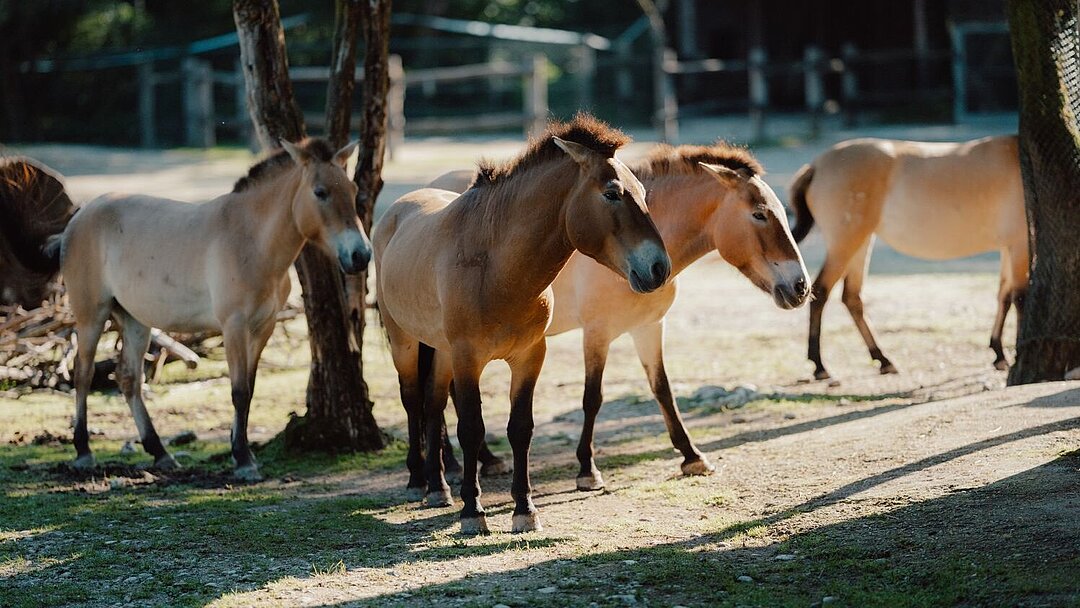
Last month, Hellabrunn Zoo welcomed a new Przewalski's horse stallion from Edinburgh Zoo with the aim of establishing a genetically valuable breeding group, as part of the European Ex-situ Programme (EEP) for the species. He joins the zoo’s two mares from Hungary and Germany, with whom he will make an important contribution to the conservation of this highly endangered wild horse species – a concrete example of the essential role modern zoos play in global species conservation.
The Przewalski's horse is the world‘s last remaining truly wild horse. In the 1960s, it was on the brink of extinction due to habitat loss, interbreeding with domestic horses, and overhunting. The species was only saved thanks to international breeding programmes coordinated among zoos. Today, the success of these conservation efforts has seen a significant number of zoo-born horses return to their historic range.
"With the arrival of the new stallion, we at Hellabrunn are once again demonstrating our commitment to the preservation of a species that would have otherwise long disappeared without the support of zoological institutions. Species conservation can only be achieved through close cooperation between zoos worldwide," said zoo director Rasem Baban.
Scientific rigour also plays a crucial role: "The targeted selection of individual horses is essential for breeding success. This is the only way in which we can ensure a stable, genetically diverse population that is able to survive in the long term," added Dr Christine Gohl, senior veterinarian at Hellabrunn Zoo and veterinary advisor to the EEP for Przewalski's horses. After about ten years without a stallion, Hellabrunn Zoo now has a male Przewalski's horse again – on the recommendation of the EEP.
The first mating attempts were observed just a few days after his arrival. However, whether these efforts were successful will only be known in about eleven months – the gestation period for Przewalski's horses. "Our hopes now rest on offspring in early summer 2026," said Baban. "A foal would not only be a benefit for Hellabrunn, but also an important contribution to the entire conservation breeding programme."
In addition, since the beginning of this year, Hellabrunn Zoo has also been supporting a reintroduction project led by the Frankfurt Zoological Society (FZS), which, in collaboration with other zoos and national parks, is organising the return of Przewalski's horses to their original home in Kazakhstan. The reintroduction to the steppe is considered an ecological milestone because the wild horses enrich the entire ecosystem and create the basis for a viable population. "With the new stallion, we want to lay another foundation for the future of the Przewalski's horse. Perhaps in a few years we will be able to release animals from Hellabrunn back into the wild," said conservation curator Dr Eric Diener. "However, our initial focus is on continuing to build up the population – under optimal conditions and in well-managed groups, such as those found in zoos or large grazing projects, such as in the Tennenlohe Forest, the Campo Pond in Hanau, or the Hortobágy National Park in Hungary."
Hellabrunn Zoo has been home to Przewalski's horses since the 1930s. In 2017, the mare Naya was the last animal to be released into the wild in Mongolia under the Return of the Wild Horses project, an in-situ conservation initiative organised by Prague Zoo.
With this commitment, Hellabrunn Zoo underscores its role as an active partner in the international species conservation network. Modern zoos are far more than just places where animals are kept: they are centres of excellence for research, conservation breeding, and educational work – and thus make a vital contribution to the protection of globally threatened species.